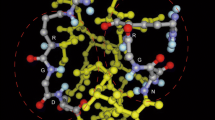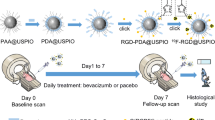ABSTRACT
Purpose
Magnetic resonance imaging (MRI) is widely used for diagnostic imaging in preclinical studies and in clinical settings. Considering the intrinsic low sensitivity and poor specificity of standard MRI contrast agents, the enhanced delivery of MRI tracers into tumors is an important challenge to be addressed. This study was intended to investigate whether delivery of superparamagnetic iron oxide nanoparticles (SPIONs) can be enhanced by liposomal SPION formulations for either “passive” delivery into tumor via the enhanced permeability and retention (EPR) effect or “active” targeted delivery to tumor endothelium via the receptors for vascular endothelial growth factor (VEGFRs).
Methods
In vivo MRI of orthotopic MDA-MB-231 tumors was performed on a preclinical 9.4 T MRI scanner following intravenous administration of either free/non-targeted or targeted liposomal SPIONs.
Results
In vivo MRI study revealed that only the non-targeted liposomal formulation provided a statistically significant accumulation of SPIONs in the tumor at four hours post-injection. The EPR effect contributes to improved accumulation of liposomal SPIONs in tumors compared to the presumably more transient retention during the targeting of the tumor vasculature via VEGFRs.
Conclusions
A non-targeted liposomal formulation of SPIONs could be the optimal option for MRI detection of breast tumors and for the development of therapeutic liposomes for MRI-guided therapy.







Similar content being viewed by others
Abbreviations
- DAPI:
-
4′,6-Diamidino-2-phenylindole
- DOPC:
-
1,2-Dioleoyl-sn-glycero-3-phosphocholine
- DOPE:
-
1,2-Dioleoyl-sn-glycero-3-phosphoethanolamine
- DSPC:
-
1,2-Distearoyl-sn-glycero-3-phosphocholine
- DSPE-PEG2000 :
-
1,2-Distearoyl-sn-glycero-3-phosphoethanolamine-N-[amino(polyethylene glycol)-2000
- EPR:
-
Enhanced permeability and retention
- GdDTPA-BMA:
-
Gadolinium-diethylenetriamine pentaacetic acid-bismethylamide
- ICG:
-
Indocynine green
- ICP-MS:
-
Inductively coupled plasma mass spectrometry
- IDL:
-
Interactive data language
- Lip(Gd/Fe):
-
Liposomes encapsulated with GdDTPA-BMA and SPIONs
- Lip(ICG):
-
Liposomes encapsulated with indocynine green
- MRI:
-
Magnetic resonance imaging
- PDI:
-
Polydispersity index
- PECAM:
-
Platelet endothelial cell adhesion molecule
- PET:
-
Positron emission tomography
- RARE:
-
Rapid acquisition with refocusing echoes
- ROI:
-
Region-of-interest
- scVEGF:
-
Single chain vascular endothelial growth factor
- scVEGF-Lip(Gd/Fe):
-
scVEGF-decorated Lip(Gd/Fe)
- scVEGF-Lip(ICG):
-
scVEGF-decorated Lip(ICG)
- SDS-PAGE:
-
Sodium dodecyl sulfate polyacrylamide gel electrophoresis
- SPECT:
-
Single photon emission computed tomography
- SPIONs:
-
Superparamagnetic iron oxide nanoparticles
- T 1 :
-
Spin–lattice relaxation time
- T 2 :
-
Transverse relaxation time
- TE:
-
Echo time
- TR:
-
Repetition time
- TSA:
-
Tyramide signal amplification
- VEGFRs:
-
Vascular endothelial growth factor receptors
References
Kato Y, Artemov D. Monitoring of release of cargo from nanocarriers by MRI/MRSI: significance of T 2 /T 2 * effect of iron particles. Magn Reson Med. 2009;61(5):1059–65.
Onuki Y, Jacobs I, Artemov D, Kato Y. Noninvasive visualization of in vivo release and intratumoral distribution of surrogate MR contrast agent using the dual MR contrast technique. Biomaterials. 2010;31(27):7132–8.
Kato Y, Pathak AP. Combined contrast and therapeutic nanocarriers for oncologic MRI. In: Phillips WT, Goins BA, editors. Nanoimaging. Singapore: Pan Stanford Publishing Pte. Ltd.; 2011. p. 1–17.
Matsumura Y, Maeda H. A new concept for macromolecular therapeutics in cancer chemotherapy: mechanism of tumoritropic accumulation of proteins and the antitumor agent smancs. Cancer Res. 1986;46(12 Pt 1):6387–92.
Jain RK. Vascular and interstitial barriers to delivery of therapeutic agents in tumors. Cancer Metastasis Rev. 1990;9(3):253–66.
Jain RK. Barriers to drug delivery in solid tumors. Sci Am. 1994;271(1):58–65.
Chauhan VP, Stylianopoulos T, Martin JD, Popovic Z, Chen O, Kamoun WS, et al. Normalization of tumour blood vessels improves the delivery of nanomedicines in a size-dependent manner. Nat Nanotechnol. 2012;7:383–8.
Backer MV, Levashova Z, Patel V, Jehning BT, Claffey K, Blankenberg FG, et al. Molecular imaging of VEGF receptors in angiogenic vasculature with single-chain VEGF-based probes. Nat Med. 2007;13(4):504–9.
Anderson CR, Rychak JJ, Backer M, Backer J, Ley K, Klibanov AL. scVEGF microbubble ultrasound contrast agents: a novel probe for ultrasound molecular imaging of tumor angiogenesis. Investig Radiol. 2010;45(10):579–85.
Zanganeh S, Xu Y, Hamby CV, Backer MV, Backer JM, Zhu Q. Enhanced fluorescence diffuse optical tomography with indocyanine green-encapsulating liposomes targeted to receptors for vascular endothelial growth factor in tumor vasculature. J Biomed Opt. 2013;18(12):126014.
Sipkins DA, Cheresh DA, Kazemi MR, Nevin LM, Bednarski MD, Li KC. Detection of tumor angiogenesis in vivo by α ν β 3-targeted magnetic resonance imaging. Nat Med. 1998;4(5):623–6.
Winter PM, Caruthers SD, Kassner A, Harris TD, Chinen LK, Allen JS, et al. Molecular imaging of angiogenesis in nascent Vx-2 rabbit tumors using a novel α ν β 3-targeted nanoparticle and 1.5 tesla magnetic resonance imaging. Cancer Res. 2003;63(18):5838–43.
Moreira JN, Ishida T, Gaspar R, Allen TM. Use of the post-insertion technique to insert peptide ligands into pre-formed stealth liposomes with retention of binding activity and cytotoxicity. Pharm Res. 2002;19(3):265–9.
Thirumamagal BT, Zhao XB, Bandyopadhyaya AK, Naranyanasamy S, Johnsamuel J, Tiwari R, et al. Receptor-targeted liposomal delivery of boron-containing cholesterol mimics for boron neutron capture therapy (BNCT). Bioconjug Chem. 2006;17(5):1141–50.
Bao L, Matsumura Y, Baban D, Sun Y, Tarin D. Effects of inoculation site and Matrigel on growth and metastasis of human breast cancer cells. Br J Cancer. 1994;70(2):228–32.
Zitvogel L, Apetoh L, Ghiringhelli F, Kroemer G. Immunological aspects of cancer chemotherapy. Nat Rev Immunol. 2008;8(1):59–73.
Chambon C, Clement O, Le Blanche A, Schouman-Claeys E, Frija G. Superparamagnetic iron oxides as positive MR contrast agents: in vitro and in vivo evidence. Magn Reson Imaging. 1993;11(4):509–19.
Imoukhuede PI, Popel AS. Quantitative fluorescent profiling of VEGFRs reveals tumor cell and endothelial cell heterogeneity in breast cancer xenografts. Cancer Med. 2014;3(2):225–44.
Duncan R, Seymour LW, O’Hare KB, Flanagan PA, Wedge S, Hume IC, et al. Preclinical evaluation of polymer-bound doxorubicin. J Control Release. 1992;19:331–46.
Kato Y, Onishi H, Machida Y. Efficacy of lactosaminated and intact N-succinylchitosan-mitomycin C conjugates against M5076 liver metastatic cancer. J Pharm Pharmacol. 2002;54(4):529–37.
ACKNOWLEDGMENT AND DISCLOSURES
This study was supported by the National Institutes of Health, CA154738 (DA, JMB, and SKS). We are grateful to Ms. Mary McAllister for editing the manuscript.
Author information
Authors and Affiliations
Corresponding author
Additional information
Yoshinori Kato and Wenlian Zhu contributed equally to this work.
Rights and permissions
About this article
Cite this article
Kato, Y., Zhu, W., Backer, M.V. et al. Noninvasive Imaging of Liposomal Delivery of Superparamagnetic Iron Oxide Nanoparticles to Orthotopic Human Breast Tumor in Mice. Pharm Res 32, 3746–3755 (2015). https://doi.org/10.1007/s11095-015-1736-9
Received:
Accepted:
Published:
Issue Date:
DOI: https://doi.org/10.1007/s11095-015-1736-9




